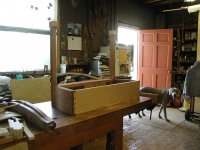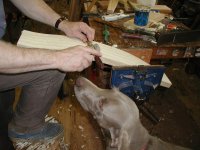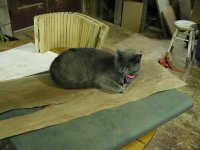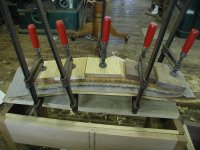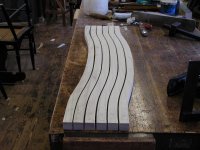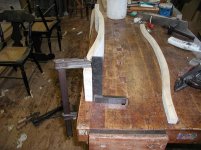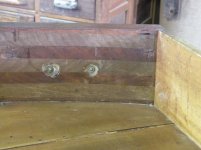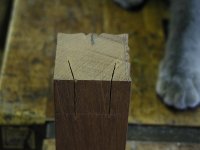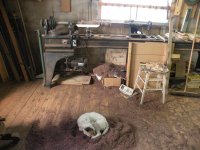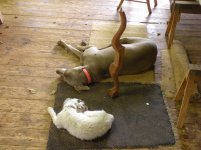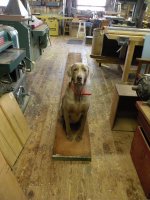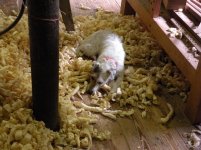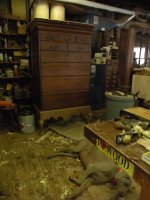You are using an out of date browser. It may not display this or other websites correctly.
You should upgrade or use an alternative browser.
You should upgrade or use an alternative browser.
Dog on it
- Thread starter Jeff L Headley
- Start date
Jeff L Headley
Well-known member
Jeff L Headley
Well-known member
Jeff L Headley
Well-known member
Jeff L Headley
Well-known member
Howard, Thank you for the question, Dog on it! The drawer front is a single stacked poplar secondary substrate with no backer boards. Yes there is a rug involved. The calls are segmented (slightly angled) pieces of poplar layed in a row and then attached together. These pieces will conform to most serpentine shapes with padding ( of your choice) in between as a call.
Attachments
Jeff L Headley
Well-known member
wrduffield
Member
Jeff, Dog on it! I think I'm barking up the same tree as Howard.
I understand the need to brick up aprons on demiluna tables and half round card tables, for example, for structural and stability reasons. It seems like it might be false economy to use this technique for this serpentine drawer front. Couldn't you saw a drawer front from a single piece of 8/4 or 10/4 quarter sawn poplar, thus saving some sawing time, the glue-up time, and avoiding the additional wear on your spoke shave or spindle sander from shaping glue joints. I suppose I'm asking where you find the break-even point between material costs and labor costs for these drawer fronts? I realize that more wood is wasted if the drawer fronts are sawn from a single block, and 10/4 qs is more expensive per bf than 4/4 flat sawn, but in this case, the scrap is less than 2 bf.
William Duffield
I understand the need to brick up aprons on demiluna tables and half round card tables, for example, for structural and stability reasons. It seems like it might be false economy to use this technique for this serpentine drawer front. Couldn't you saw a drawer front from a single piece of 8/4 or 10/4 quarter sawn poplar, thus saving some sawing time, the glue-up time, and avoiding the additional wear on your spoke shave or spindle sander from shaping glue joints. I suppose I'm asking where you find the break-even point between material costs and labor costs for these drawer fronts? I realize that more wood is wasted if the drawer fronts are sawn from a single block, and 10/4 qs is more expensive per bf than 4/4 flat sawn, but in this case, the scrap is less than 2 bf.
William Duffield
Jeff L Headley
Well-known member
Stacking the pieces for this serpentine drawer front is a much stronger method than just cutting the drawer front out of a solid piece of wood. This is also how most of the originals I have seen or worked with were done. The grain when cutting out a solid board for the serpentine drawer front could fracture across the grain also when veneering or overlaying the movement of the wood needs to be considered. The stacked method doesn't move as much. Moisture and heat is this methods enemy. Dog on it! Once stacked each layer with its own grain orientation helps hold the piece it is attached to in alignment. Quartersawn pieces work better. I use seat webbing to hold the calls together.
Jeff L Headley
Well-known member
Jeff L Headley
Well-known member
Jeff L Headley
Well-known member
Jeff L Headley
Well-known member
Jeff L Headley
Well-known member
Jeff L Headley
Well-known member
"Dog on it" is the first thing that I will say
But then hay dude my reply will convey
After the cows come home and the fence is repaired
Please come to our shop where secret are shared
We will add to your skill level with some of our techniques
They might last for years or just a few weeks
Each process you take home might help you to make
That piece of a lifetime or to correct a mistake
Period joinery is what we will cover
Each class is as good as one from my brother
My comments are meant as only in jest
Because we all know that he is the best
With all of our classes we will try to give
An unequaled experience with a lifetime to live
to create that piece which you will send
to your wife or your children, or even a friend
After taking a period construction class from our shop
We will advise you with your climb to the top
We will help you with all that you strive
To make sure to keep your business alive
In today's economy we all need
all the help we can get all the help we can heed
So please let us help you with little to spare
From what we can offer from what we can share
The things we can offer the things we can show
are all left to help you, to help you to know
What might be your wants, what might be your cravings
What might be a small dog lying in your shavings
But then hay dude my reply will convey
After the cows come home and the fence is repaired
Please come to our shop where secret are shared
We will add to your skill level with some of our techniques
They might last for years or just a few weeks
Each process you take home might help you to make
That piece of a lifetime or to correct a mistake
Period joinery is what we will cover
Each class is as good as one from my brother
My comments are meant as only in jest
Because we all know that he is the best
With all of our classes we will try to give
An unequaled experience with a lifetime to live
to create that piece which you will send
to your wife or your children, or even a friend
After taking a period construction class from our shop
We will advise you with your climb to the top
We will help you with all that you strive
To make sure to keep your business alive
In today's economy we all need
all the help we can get all the help we can heed
So please let us help you with little to spare
From what we can offer from what we can share
The things we can offer the things we can show
are all left to help you, to help you to know
What might be your wants, what might be your cravings
What might be a small dog lying in your shavings
Attachments
Jeff L Headley
Well-known member
rchampagne
Well-known member
Wow, that was like Shakespeare meets Dr. Suess! Possibly the first poem (?) about period furniture classes ever. Very nice,
Rob
Rob
Share:

